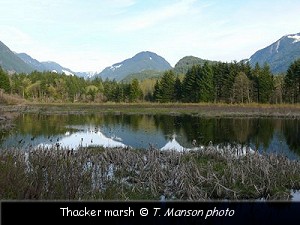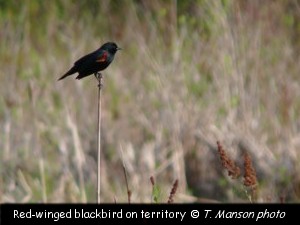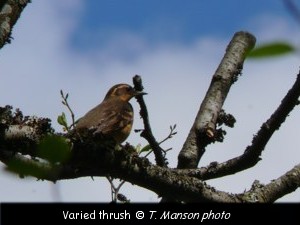Sucker Creek Fish Enhancement Area
by Thor Manson
The Sucker Creek Fish Enhancement Area, and the surrounding landscapes provide a rich environment for the  aviafauna of the Hope Region. The riparian features of the creek, and adjacent Thacker Marsh, and the partially intact mixed forest provide sustenance, and shelter for a number of species. In the past year, or more, a conglomerate of organizations have worked together to enhance fish habitat in, and next to the creek. A new trail with accompanying new infrastructures has made the site more user friendly for residents, and visitors alike. aviafauna of the Hope Region. The riparian features of the creek, and adjacent Thacker Marsh, and the partially intact mixed forest provide sustenance, and shelter for a number of species. In the past year, or more, a conglomerate of organizations have worked together to enhance fish habitat in, and next to the creek. A new trail with accompanying new infrastructures has made the site more user friendly for residents, and visitors alike.
Traditionally, the area, except for the lower portion of the creek, where it empties into the Coquihalla River, and forms a small sandy beach, has been little used by humans. A section of the Trans Canada Trail runs from the parking lot of the Enhancement Area in a easterly direction. This trail, after paralleling Thacker Marsh for about 1 km, then historically wound its way beside a farm property. Now, however, a subdivsion is being constructed on the site of the former farm. This subdivision, along with another one being built a little further up the road, will definitely increase use of the trail. It will be interesing to see what impact, if any, this will have on the wildlife of the area.
A few species stand out as being predominent to the regular observer. Red-winged Blackbirds use the marsh area as a breeding site. They are certainly amongst the first to start singing, and are a welcomesign of spring. In the fall and early winter, during and after the spawining periods of Chum and Coho Salmon in the creek, American Dipper are easily observed. Similarly, Glaucous-winged Gulls will be viewed at the mouth of the creek. Alaskan Song Sparrow, Steller Jay, chickadees, Spotted Towhee, Dark-eyed Juncos, and Ruby-crowned Kinglet are full time residents, and Winter Wren can often be heard with their persistent “chatter “. as a breeding site. They are certainly amongst the first to start singing, and are a welcomesign of spring. In the fall and early winter, during and after the spawining periods of Chum and Coho Salmon in the creek, American Dipper are easily observed. Similarly, Glaucous-winged Gulls will be viewed at the mouth of the creek. Alaskan Song Sparrow, Steller Jay, chickadees, Spotted Towhee, Dark-eyed Juncos, and Ruby-crowned Kinglet are full time residents, and Winter Wren can often be heard with their persistent “chatter “.
Canada Geese use the marsh as a nesting site, and Wood Ducks, and Mallard do the same in quiet areas next to the creek. Based on the number of Great Blue Herons that use the marsh, they invariably also nest nearby. Belted Kingfisher will occasionally be spotted.

Five members of the Woodpecker Family live in the area, and are most easily observed along the Trans Canada Trail, both paralleling the marsh, and further along in the mixed forest bordering the new subdivision. Downy, Hairy, and Pileated Woodpecker can be seen, along with Red-breasted Sapsucker, and Northern Flicker. A medium sized flock of Evening Grosbeak use the wooded area near the parking lot, and can be seen in just about any season.
American Robins, as in most areas of southern B.C., become much more prominent in Spring, as Varied Thrush  start to leave this lower elevation. Later in the Spring, the beautiful song of the Swainson’s Thrush will be heard in the adjacent woodlands. Cedar Waxwing will also be present. start to leave this lower elevation. Later in the Spring, the beautiful song of the Swainson’s Thrush will be heard in the adjacent woodlands. Cedar Waxwing will also be present.
Another sign of Spring is the return of the Turkey Vultures, and they will be present in small numbers. Both Cooper’s and Sharp-shinned Hawks have been seen. Red-tailed Hawk is regular. Bald Eagle will be about, and, in winter, Rough-legged Hawk have been sighted.
Band-tailed Pigeons return to the area in the Spring, and can, most reliably, be seen in tall trees where the Trans Canada Trail moves into the new subdivision.
Warblers also return in the Spring with most of the regular Wood Warblers for South West B.C. being seen, including Black-throated Grey.
A Long-eared Owl was seen from the Trans Canada Trail in the fall of 2006, and it can be presumed, from sightings nearby that both Barred Owl, and Northern Pygmy Owl are in the vicinity.
The Fraser Valley Regional District; ( parks division ), has erected nest boxes in the area for chickadees, and/or swallows, and Brown Creepers. In the summer, Vaux’s Swifts can also be seen aloft, hawking for insects. In the spring and summer, and early fall, Osprey can be viewed from the mouth of Sucker’s Creek as they hunt along the course of the Coquihalla River.
The significant mammal of the area is the American Beaver, and evidence of its work is very noticeable in the marsh with the presence of beaver dams, and along the trails with the downed trees, as the result of the beaver’s work. Very occasionally, one will be seen swimming in the marsh. During the summer, one can often see turtles basking in the sun.
Access:
(From the West). Exit Highway 1 at Hope, ( exit 170 ). Turn left at the first set of lights, and right onto the Old Hope Princeton at the second set. Turn left on 6th ave, by the Chevron Station, and then right onto Kawkawa Lake road. After crossing the Coquihalla River, turn left on Union Bar Road. The parking lot will be on your right about 100metres from the turn. From the East, via highways 3, and 5, take the first exit into Hope. This road is the Old Hope Princeton highway. Turn right at 6th ave by the Chevron Station, and proceed as per western directions. From the TransCanada East, through Hope, turn left at the first set of lights, onto the Old Hope Princeton, and follow directions as per above.
From the parking lot, take the short trail from across Union Bar Road down to where Sucker Creek empties into the Coquihalla River There are interesting interpretive signs along the way. Alternately, take the Trans Canada Trail heading in a easterly direction. Intially, the observer will see another section of Sucker Creek, and then the view to the left opens up to Thacker Marsh. Follow this trail for about 1km. The trail then leads to the new subdivision, with mixed forest on the left. The TransCanada Trail will continue, and cross Kawkawa Lake Road where, after passing some more houses, will form into a trail again, which provides alternate foot, and bike access to the Othello Tunnels. This part of the trail was the former railbed for the Kettle Valley Railway. Thirdly, from the parking lot, follow Union Bar Road in a north eastely direction. The road,with a small bridge, crosses Sucker Creek, and provides an alternate view of Thacker Marsh with a spectacular view of Hope Mountain. It then climbs, providing the observer with views of Kawkawa Lake. Following it for a few more kilometres will lead the observer to elevated views of the Fraser River north of Hope.
For more information view the Thacker Regional Park website. |